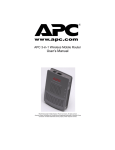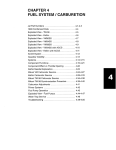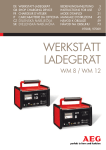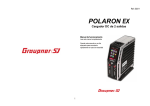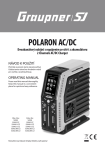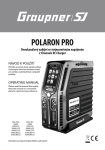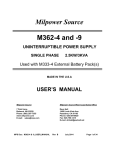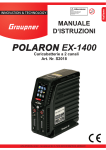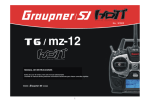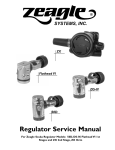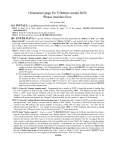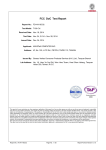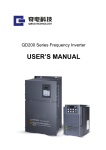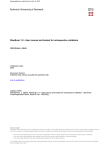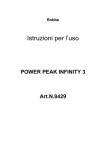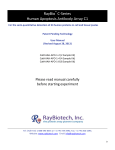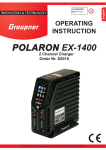Download 2 CH DC CHARGER
Transcript
2 CH DC CHARGER OPERATING INSTRUCTION Prior to use, please read this manual thoroughly. Keep this manual in a convenient place for quick and easy reference. - CONTENTS - BEFORE USE SUPPROT AND SERVICE CUSTOMER SUPPORT INTERNET SALES SITE WARRANTY REGULATION A/S REGULATION BOX CONTENTS SAFETY PRECAUTIONS SPECIFICTION CHARGER CONTROL IDENTIFICATION MENU CONFIGURATION ACTION BUTTONS MENU DESCRIPTION BATTERY CONNECTION INPUT POWER SETUP MAIN PAGE PROFILE PAGE DISPLAY BATTERY NAME EDITING CHARGE PAGE LiPo, LiIon, LiFe BATTERY CHARGE SETUP NiCd/ NiMH BATTERY CHARGE SETUP Pb BATTERY CHARGE SETUP LiPo, Lilon, LiFe, NiCd, NiMH, Pb BATTERY CHARGE PROCESS CHARGE MODE PER BATTERY TYPE DISCHARGE PAGE LiPo, LiIon, LiFe, NiCd, NiMH, Pb BATTERY DISCHARGE MODE LiPo, Lilon, LiFe, NiCd, NiMH, BATTERIES DISCHARGE PROCESS DISCHARGE MODE PER BATTERY TYPE CYCLE PAGE LiPo, Lilon, LiFe, NiCd, NiMH, Pb BATTERIES CYCLE PAGE LiPo, Lilon, LiFe, NiCd, NiMH, Pb BATTERIES CYCLE PROCESS CYCLE OPERATION MODE PER BATTERY TYPE BALANCE PAGE DATA VIEW PAGE USER SETUP PAGE MISE PAGE (ADDITION FUNCTION) SERVO AND BRUSHLESS MOTOR TESTING SETUP BRUSHED MOTOR SETUP WARMER SETUP FACTORY SETUP AND SCREEN CALIBRATION DATA LNITIALIZATION TOUCH CALIBRATION RESOURCE UPGRADE BLC PORT TEST 3 4P 4P 4P 4P 4P 4P 5P 5~6P 7~8P 9~10P 11P 11P 11P 11P 12P 12P 12~13P 13P 13P 14~19P 14P 15P 15P 16P 16~18P 20~23P 20P 21P 21~22P 23~27P 24P 24P 25P 27~28P 28~29P 29~30P 31P 31~33P 34~35P 35~37P 36~37P 38P 38P 39P 39P PIC SLAVE MICOM UPGRADE (PRODUCT UPDATE) ERROR MESSAGE USE OF PROBLEM AND PRECAUTION FOR POLARON EX DC CHARGER NiCd/MH BATTERY WARNNING Pb BATTERY WARNNING Lilon, LiPo, LiFe BATTERY WARNNING LITHIUM POLYMER (LiPo) BATTERY WARNNING 39P 40~42P 43~45P 44P 44P 44P 45~46P ◎ BEFORE USE Thank you for purchasing POLARON EX 2CH DC Charger. This system is extremely versatile and may be used by beginners and pros alike. In order for you to make the best use of your system, please read this manual carefully. If you have any difficulties while using your system, please consult the manual, our online Frequently Asked Questions (on the web pages referenced below), your hobby dealer, or the Graupner/SJ Service Center. ◎ SUPPORT AND SERVICE Customer support Please feel free to ask any question by e-mail or phone. We’ve been trying to deal with your question. We are open from nine to six, Monday to Friday in Korea. We may respond to your question by e-mail as soon as possible when we are close. Internet sales site Please feel free to contact “www.openhobbby.com” to stay up to date the latest Graupner/SJ Firmware and the newest product line up A/S regulation Only when the product is faulty after normal operation within the warranty period, we will repair the product for free based on our regulations. The repair will be paid for by the consumer when the damage is due to use in improper ways or beyond the warranty period. Warranty regulation Refer the WARRANTY CARD in a Package ◎ OPENHOBBY A/S CENTER 8F, 202 Dong, Chunui Techno-Park II, 18, 198 street, cheon-Shi, Gyungki-Do KOREA 420-857 Phone: 82-32-623-0706 FAX: 82-32-623-0720 Customer Service E-mail: [email protected] Bucheon-ro, Wonmi-Gu, Bu- 4 - Do not use in the too cold place or hot place, charge may not output normally or may not ◎ BOX CONTENTS 1. Charger 4. USB cable 7. User manual 2. 7Cells Balance board/ Cable (EH to XH) 2 pairs 5. OUT PUT cable with alligator clip 2 pairs 8. Warranty card be operated. 3. Temperature sensor 2pcs 6. Charger rack - Make sure to use in a well ventilated place and do not block the cooling fan (rear) and air inlet (front). - Make sure to use in the proper place that you can see TFT panel since TFT panel might not be visible under strong sunlight. - We strongly recommend balancing a Lithium pack, An unbalanced pack can cause damage and in extreme cases can cause a fire. ◎ SAFETY PRECAUTIONS - Make sure to connect one battery pack to a balance board. If not, battery or charge can get the damage. - Do not attach the charger to both of AC and DC power source at the same time. - Never connect the input jack (DC input) toAC power. - Make sure to disconnect the docking power supplier when to input DC power source to the rear terminal of charge. - Make sure to program the input power setup correctly at USER SETUP mode. - Make sure to program the input power setup correctly at USER SETUP mode when to use - Charger do not charge the battery of which voltage is below 2.8V per cell. If the battery is forced to charge, the pack can cause damage and in extreme cases can cause a fire - The default charging current is 1C. Make sure to check the voltage and temperature of battery when to charge with more than 1C. - Do not charge Lithium Polymer battery packs at greater than 4.2V per cell. - Always disconnect the battery after charging, and let the charger cool between charges. the docking power supplier. - Be cautious about an automobile battery dead, when power source is supplied from an automobile. - Make sure to supply enough power source to charger. The charger output is maximum 400W for each channel. - If possible, put the battery in a safety bag when to charge or discharge. - Make sure to pay attention to charger during use. Disconnect the battery and remove input power from charger immediately if the charger becomes hot and keep the charger and battery cool down before reconnecting. - Do not attempt to charge dead or damaged batteries. - Make sure to charge the pack consisted of the same type of batteries. - Do not attempt to charge a battery pack containing different types of batteries. - Do not use the too shot cable or damaged cable. - Make sure to charge a pack for each channel. - Do not use near a flammable object and use in a well ventilated area, the gas in explosion possibilities may be generated during use. - Do not reverse the positive and negative terminals. Wrong connection will damage the battery and may cause damage to the charger. - Make sure to use only rechargeable batteries and ensure them meet the requirements of this charger. - Do not allow water, moisture or foreign objects into the charger. - Do not use in humid place and do not operate with wet hands. - Do not attempt to dismantle the charger. - Do not use on the fleecy material such as carpet, blanket, bed, cushion and make sure to use in a hard and flat surface. 5 6 ◎ SPECIFICATION MODE Power Supply TYPE DC Input Memory 40 (CH1 20/ CH2 20) Display 3.0” TFT LCD W/Touch Screen Battery Types NiCd, NiMH, LiPo, LiIon, LiFe, Pb NiCd, NiMH ,Pb Operating Modes LiPo, LiIon, LiFe SPECIFICATION 11-28V DC/AC by SMPS Charge, Discharge, Cycle Charge, Discharge, Cycle, Store Automatic charge Charge (NiCd, NiMH) Normal charge Discharge Voltage N-STORE charge Charge (Pb) CC-CV charge Automatic Discharge Operating Modes Discharge (NiCd, NiMH, Pb) Normal Discharge Linear Discharge Normal Discharge Discharge (LiPo, LiIon, LiFe) Linear Discharge Link Discharge CYCLE Charge (LiPo, LiIon, LiFe, Pb) CYCLE DisCharge (LiPo,LiIon,LiFe, Pb) CC-CV charge Normal Discharge Linear Discharge CYCLE Charge/DisCharge (NiCd, NiMh) Number of Cells Charge Current Discharge Current Charge Voltage 7 Normal Charge/DisCharge Linear Charge/DisCharge Auto Charge/DisCharge NiCd, NiMH 1 ~ 14 Cells/2CH LiPo, LiIon, LiFe 1 ~ 7 Cells/2CH Pb 1 ~ 12 Cells/2CH (2V~24V) NiCd , NiMH 0.1A ~ 20.0A (max 400W)/2CH LiPo, LiIon, LiFe 0.1A ~ 20.0A (max 400W)/2CH NiCd , NiMH, LiPo, LiIon, LiFe, Pb 0.1A ~ 10.0A (max 60W)/2CH LiPo 3.70 ~ 4.30V/cell LiIon 3.60 ~ 4.20V/cell LiFe 3.30 ~ 3.70V/cell 2.50 ~ 4.20V/cell LiIon 2.50 ~ 4.10V/cell LiFe 2.00 ~ 3.70V/cell Pb 1.50 ~ 2.00V/cell Off ~ 500mA Balancing current LiPo, LiIon, LiFe MAX 350mA Cycle time 1~10 Cycles Cycle delay 1~30 min Cycle direction C>D / D>C / D:C>D NiCd 5 ~ 25mV/cell NiMH 0 ~ 15mV/cell Centigrade 10 ~ 80°C Fahrenheit 50 ~ 176°F NiCd , NiMH OFF, 10~150% LiPo, LiIon, LiFe OFF, 10~120% Start delay timer NiCd , NiMH, LiPo, LiIon, LiFe, 1 ~ 150 min Safety timer Pb 10 ~ 900 min & Off PC communication NiCd , NiMH, LiPo, LiIon, LiFe, data logging Firmware upgrade Pb External mini USB Cooling system YES 50*50*10mm * 2ea fan 12V output 1368g (48.25 oz) B terminal in the side, B terminal in the rear USB YES USB B-type-5V 2.5A output Ext.Module socket YES EH 5P Motor Test socket YES ZHR Servo Test socket YES Futaba 3P socket Cycle Mode Peak sensitivity Temperature Sensor Q-STORE charge CV-Link charge 0.10 ~ 1.30V/cell LiPo NiCd, NiMH FAST charge Charge (LiPo,LiIon,LiFe) 1.80 ~ 2.45V/cell NiCd, NiMH Trickle Current Linear charge CC-CV charge Pb Max charge capacity SMPS Docking terminal Auto Mode (Charge Current/20) B terminal in the side Dimensions 88.2x203.4x196.3mm (3.47x8.00x7.73 in) Weight 1368g (48.25 oz) 8 ◎ CHARGER CONTROL IDENTIFICATION TOP BACK FRONT RIGHT ④ ⑤ ⑥ ⑦ ② ⑧ ⑪ ① ⑨ ③ ⑩ ⑫ ⑬ ⑭ ① Mini USB 9 ② DC Input ③ Fan ④ ⑦ ⑩ ⑬ 3.0”TFT LCD W/Touch Screen Charge/discharge status LED bar Temperature sensor port Motor sensor ⑤ ⑧ ⑪ ⑭ LED Indicator for Charge/ discharge Battery socket USB +5V 2.5A Servo test ⑥ Channel selection button ⑨ Balance port ⑫ EXT Module 10 ◎ MENU CONFIGURATION Graupner/SJ POLARON Series charger is equipped with a highly sensitive touch screen. You just need to tap icons to access to every mode and set up your device. ACTION BUTTONS retain more capacity than others, so over time the pack can become unbalanced. If an unbalanced pack is then used, some of the cells will exceed their maximum voltage when charged and others their minimum voltage when discharged, which causes damage to the cells. When a Lithium cell is overcharged, it can cause damage and in extreme cases can cause a fire ◎ INPUT POWER SETUP This charger has 40 memories (CH1 20 /CH2 20) that each - ESC button: Getting back to the previous page, store the setup data and etc. - DEC button: Page transition, Data setup and etc. battery can be resisted so the basic programming setup helps you to manage batteries efficiently The charger should be connected to the docking SMPS or a suitable 11-28V DC power source, ensuring that the black connector is connected to the - INC button: Page transition, Data setup and etc. - ENTER button: Accessing to the next page, Completing data setup, Starting/completing to operate, Storing the setup data and etc. negative (-) and the red to the positive (+) Input voltage and current can be programmed at USER SET (ref 30 page), this charger will control output automatically depending on power input source MENU DESCRIPTION Main page PROFILE CHARGE DISCHG CYCLE BALANCE DATA MISC USER SET Function Battery name, type, capacity, number of cells, memory number, memory copy Setup battery charge data Setup battery discharge data Setup cycle type and delay time of charge / discharge ( using charge / discharge setup data ) Display cell voltage and related data, setup balance data Display the completed data and battery status Setup servo, motor and warmer data Setup input data, warning, date, time, user name and etc. ◎ BATTERY CONNECTION POLARON EX 2CH DC charger has two sets of outputs on the front of the charger. Channel 1 is on the left and channel 2 on the right. Each channel has two 4mm banana sockets and 7 cell balance port and a temperature sensor input port. You will need an appropriate charge lead to suit the specific connector on your battery. Connect this charge lead to the 4mm output sockets on the charger channel you want to use, with the positive (+) lead connected to the red socket and the negative (-) lead to the black socket. Only connect the battery to the charge lead AFTER the charge lead has been connected to the charger, as the connectors on the charge lead could touch together and cause the battery to short circuit. When charging a Lithium pack, make sure that the balance lead is connected to the charger. The charger has a ‘JST-EH’ type balance port, but also comes with other balance adaptor boards. To use an adaptor board, connect the supplied balance adaptor board lead to the charger and then connect the board that works with your battery balance connector. If the main battery power leads ONLY are connected to the output banana sockets, without connecting the balancing connector to the balancing port on the charger, the charger will charge or discharge the connected Lithium pack without balancing it. We always recommend balancing a Lithium pack, because some cell may 11 ▲ Power on ◎ MAIN PAGE - You may tap channel number on the bottom box to select channel and the main page of the selected channel in red is displayed. Tapping the other channel allows to select other USER NAME channel. - The date and time are displayed on the top of main page and the data can be programmed at USER SET - Tapping icons on main page allows to access to the tapped page. When to tap icons, icon is activated in dark gray and charger beeps ◎ PROFILE PAGE Profile page is the main functional page for this charger. It is used to setup battery name, battery type, capacity, number of cells and set memory number, as well as being used to initiate charging, discharging, cycling and balancing mode functions. The related functions with charge and discharge are operated according to the stored data of charging, discharging, cycling and balancing mode. 12 Display ◎ CHARGE PAGE PROFILE AM 00:00:00 #01 BATTERY NAME Section 1 TYPE Voltage Capacity 2S LiPo Memory number & Battery name 25.2V Battery type 01000mAh #02 BATTERY NAME TYPE Section 2 Voltage Capacity CH1 LiPo 2S Number of cells in series Battery voltage When to tap CHARGE icon on main page, you may access to charge mode. The parameters in this mode depends on the selected battery type at profile page USER NAME Battery capacity 25.2V Tap CHARGE icon on main page to charge 01000mAh CH2 1) Tap memory number box in section 1 to activate and tap INC/DNC buttons to set memory number. 1~20 numbers are available and changeable. Press and hold memory number box to access battery name page 2) Tap battery type, number of cells and capacity to activate. Tapping INC/DEC buttons edits the battery parameters 3) Memory copy Tap number box on Section 2 to activate and tap INC/DNC buttons to set memory number. Tap Enter button to copy the battery parameters of Section 1 to the battery parameters of Section 2 4) Tap Enter button to store the battery parameters and tap ESC button to get back to the previous page It is very important that the correct battery parameters are entered, as incorrect values could cause the charger to seriously damage your battery which could result in a fire ! Battery name editing The battery parameters on charge page when to select LiPo, Lilon, LiFe The battery parameters on charge page when to select NiCd, NiMH The battery parameters on charge page when to select Pb battery It is used to program the battery parameters. Tap each data box to activate in blue and tap INC/DEC button to edit the battery parameters. LiPo, LiIon, LiFe battery charge setup 12 characters are available. Tapping Clr in the red circle erases the default name and the new name can be entered. When to tap “ABC”, “abc”, “123, you may access to each page of upper and lower case, numbers with special characters and tap the character that you want to use as a name. Tapping ESC button makes you get back to the previous page. 13 - Voltage - Current : Maximum cell voltage, CV (Constant Voltage) : Charge current, tapping INC/DEC buttons can activate and edit the parameter The default charge current is set to 1C (1 x capacity), however this can be adjusted from 0.1 to 20 Amps and operated within 400W 14 : Cut off temperature. When used with the optional temperature sensor, a safety cut-off temperature can be set, so that charging or discharging is terminated automatically if the temperature sensor detects the battery temperature rising above the preset temperature. - Max Capacity : The maximum capacity setting is used to terminate a charge if the charger exceeds the preset percentage of the battery capacity since the batteries that are decrepit or in bad balancing or programmed improper parameters can be overcharged - Safety Timer : The safety timer can be used to terminate a charge if it is not completed within the preset time period. It is used to protect battery : The battery voltage in store mode. It is used to terminate a charge if it is reach the - Store Volt preset voltage - Cut-Temp The programmed data is stored to memory and ready to charge battery now. Tapping Enter button makes the charger initiated to charge battery after the process of balance connector checking, charge mode checking, number of cells checking, delay time setup. If the programming setup is performed properly, the charger shows 5 seconds countdown without any control of it Below picture shows the sequence of charging LiPo, Lilon, LiFe, NiCd, NiMH, Pb battery charge process NiCd/ NiMH battery charge setup - Current - - - - - : Charge current, tapping INC/DEC buttons can activate and edit the parameter The default charge current is set to 1C (1 x capacity), however this can be adjusted from 0.1 to 20 Amps and operated within 400W Peak Sens : Delta-peak cut-off voltage. It is used to charge NiCd/ NiMH battery. When the pack voltage peaks, the pack becomes hot and the pack voltage drops off. This charger terminates a charge using Delta-peak cut-off. The default parameter is 3mV/cell for NiMH and 7mV/cell for NiCd Tricke : Trickle charge current, With NiCd and NiMH type batteries, it is recommended that the pack is trickle charged after the main charge has completed, so that the battery is kept fully charged and is ready to be used. Therefore, we suggest setting the trickle charge current to around 10% of the pack capacity (Possible to set max 500mA) Cut-Temp : Cut off temperature. When used with the optional temperature sensor, a safety cut-off temperature can be set, so that charging or discharging is terminated automatically if the temperature sensor detects the battery temperature rising above the preset temperature. Max Capacity : The maximum capacity setting is used to terminate a charge if the charger exceeds the selected percentage of the battery capacity since the batteries that are decrepit or programmed improper peak sens can be overcharged Safety Timer : The safety timer can be used to terminate a charge if it is not completed within the preset time period. It is used to protect battery The charger checks whether balance board is connected. It is automatic process Charge mode selection Charge mode and delay time are programmed. Tap the box to activate in blue and tap DEC/INC button to select the desired mode. Charge modes are explained below The charger initiates to charge after 5 seconds countdown and when to tap Enter button the charger initiates to charge immediately Pb battery charge setup - Voltage - Current : Maximum cell voltage, CV (Constant Voltage) : Charge current, tapping INC/DEC buttons can activate and edit the parameter The default charge current is set to 1C (1 x capacity), however this can be adjusted from 0.1 to 20 Amps and operated within 400W - Cut-Temp : Cut off temperature. When used with the optional temperature sensor, a safety cut-off temperature can be set, so that charging or discharging is terminated automatically if the temperature sensor detects the battery temperature rising above the preset temperature. - Max Capacity : The maximum capacity setting is used to terminate a charge if the charger exceeds the preset percentage of the battery capacity since the batteries that are decrepit or in bad balancing or programmed improper parameters can be overcharged - Safety Timer : The safety timer can be used to terminate a charge if it is not completed within the preset time period. It is used to protect battery 15 Delay time setup 1~150 minutes can be set. The charger initiates to charge battery after the lapse of the preset time. Charge mode per battery type < AUTOMATIC > NiCd/NiMH : This is an automatic charge, which checks the number of cells and discharge current. The charger calculates the internal resistance and charge current for every period of time and then automatically adjust the discharge current to make sure the best discharge current is delivered to your pack. PEAK SENS, NiCd=7mV/cell, NiMH=4mV/cell are applied automatically and only CUT-TEMP can be programmed 16 < NORMAL > NiCd/NiMH : The charger will charge the pack with the preset charge current, but will stop charging every minute to calculate voltage and detect Delta peak. This allows for better peak detection so it is better to for the time worn battery and unstable charge cable < LINEAR > NiCd/NiMH : The charger will charge the pack with the preset charge current and detect Delta peak every second without stopping to charge. Since changing the charge cable contact point might terminate charging, make sure not to touch charge cable during charging. The charger will stop charging for a few seconds in 10 minutes to calculate the internal resistance. This method allows to detect ZEROpk (0mV/cell) and terminate without temperature rise < CC/CV > LiIon/LiPo/LiFe/Pb : The charger will charge the pack with the preset charge current and detect Delta peak every second without stopping to charge. Since changing the charge cable contact point might terminate charging, make sure not to touch charge cable during charging. The charger will stop charging for a few seconds in 10 minutes to calculate the internal resistance. This method allows to detect ZEROpk (0mV/cell) and terminate without temperature rise < FAST > LiIon/LiPo/LiFe : The charge will charge the pack with constant current after constant voltage charging The calculated voltage from balance cable is used to control so the pack can be charged safely (Only the battery equipped with balance cable should be charged, excluding Pb battery) < STORE > LiIon/LiPo/LiFe : The charge will charge/discharge to store the pack with constant voltage after constant current charging/discharging. CC/CV is applied to N-STORE and FAST is applied to Q-STORE Charge mode of POLARON EX CHARGER LiPo, LiIon, LiFe CC-CV FAST N-STORE Q-STORE CV-LINK : : : : : Normal charge Fast charge Normal store charge Quick store charge The packs that has the same number of cells and capacity can be charged simultaneously (If the cells are different, error is occurred) NiCd, NiMH AUTO : The charge will automatically adjust the charging condition NORMAL : Normal charge LINEAR : The preset current is maintained throughout the charge. Pb CC-CV : Normal charge In CV-LINK mode, the packs should have the same voltage, capacity and number of cells. Since the charging parameter is different, it causes the damage to batteries. Please install balance cable to CH1, CH2 This page shows the process of battery check when the balancer is connected. The next page is accessed automatically When to tap Enter button the charger initiates to charge immediately Battery Cell Checking Number of cells checking When to connect balance board, the charger can only check the number of cells. If the confirmed number of cells is not correct, tap ESC button to get back to the previous page and check the parameters again. If the number of cells is correct, the next page is accessed automatically. When to be initiated without balance board, it is activated for you to check and decide the number of cells. When to tap Enter button, the charger initiates to charge immediately (This page doesn’t appear when NiCd, NiMH batteries is connected) 17 18 This page shows the charging process with parameters and graph. Voltage and current will reach to the preset parameters. The preset current might have limitation depending on charge/discharge capacity and input voltage setup. Max charge is 400W and max discharging is 60W When to tap graph, the data view page is accessed. The operating data is shown. Please refer page (27~29 page) ◎ DISCHARGE PAGE When to tap DISCHARGE icon on main page, you may access to discharge mode. The programming setup and page transition is the same with CHARGE mode USER NAME Tap DISCHARGE icon to discharge at main page When to tap the part in red circle, Set current window appears and you may change the charge current during operating and set current window disappears when to tap X button. This setup is applied to the charger that is charging and it is not stored to memory This page shows discharge setup when to select LiPo, Lilon, LiFe, NiCd, NiMH, Pb batteries When to tap the part in red circle, it is activated in blue and the parameters can be programmed When to STOP button, the pop up window appears which asks whether to stop operating. When to tap STOP or ESC button, the charger will stop or continue the charge LiPo, LiIon, LiFe, NiCd, NiMH, Pb battery discharge mode - Voltage - Current - Cut-Temp - Max Capacity 19 : Final discharge voltage for each cell can be programmed : Discharge current, this can be adjusted from 0.1 to 10 Amps and operated within max 60W : Cut off temperature. When used with the optional temperature sensor, a safety cut-off tem perature can be set, so that charging or discharging is terminated automatically if the temperature sensor detects the battery temperature rising above the preset temperature. : The maximum capacity setting is used to terminate a charge if the charger exceeds the preset percentage of the battery capacity since the batteries that are decrepit or in bad balancing or programmed improper parameters can be over discharged 20 The programmed data is stored to memory and ready to charge battery now. Tapping Enter button makes the charger initiated to charge battery after the process of balance connector checking, charge mode checking, number of cells checking, delay time setup. If the programming setup is performed properly, the charger shows 5 seconds countdown without any control of it. Below picture shows the sequence of charging LiPo, Lilon, LiFe, NiCd, NiMH batteries discharge process The charger checks whether balance board is connected. It is automatic process < NORMAL > - The charge will stop discharging and calculate the average resistance every minute < LINEAR > - The charger will discharge the pack without stopping. The charger calculates the internal resistance once by stopping the discharge in 3 minutes since the charge started Discharge mode of POLARON EX CHARGER LiPo, LiIon, LiFe NORMAL : Normal discharge LINEAR : The preset current is maintained throughout the discharge. LINK : The packs that have the same number of cells and capacity can be discharged simultaneously NiCd, NiMH, Pb AUTO : The charge will automatically adjust the discharging condition NORMAL : Normal charge LINEAR : The preset current is maintained throughout the discharge. In LINK mode, the packs should have the same voltage, capacity and number of cells. Since the charging parameter is different, it causes the damage to batteries. * Please install balance cable to CH1, CH2 Discharge mode selection Discharge mode and delay time is programmed. Tap the box to activate in blue and tap DEC/INC button to select the desired mode.Discharge modes are explained below This page shows the process of battery check when the balancer is connected. The next page is accessed automatically When to tap Enter button the charger initiates to charge immediately The charger initiates to discharge after down counting and when to tap Enter button, the charger initiates to charge immediately Delay time setup 1~150 minutes can be set. The charger initiates to discharge battery after the lapse of the preset time. Discharge mode per battery type < AUTOMATIC > - This is a automatic discharge that checks the number of cells and discharge current. The charger calculates the internal resistance and discharge current for every period of time and then automatically adjust the discharge current to make sure the best discharge current is delivered to your pack. - Cutoff voltage, NiCd=0.9V/cell, NiMH=0.8V/cell, LiIon/Po=3.0V/cell, LiFe=2.5V/cell, Pb=1.8V/cell, are applied (Charging Lithium and Pb batteries after discharging don’t affect to battery performance) - The preset CUT-TEMP is applied 21 Number of cells checking When to connect balance board, the charger can only check the number of cells. If the confirmed number of cells is not correct, tap ESC button to get back to the previous page and check the parameters again. If the number of cells is correct, the next page is accessed automatically. When to be initiated without balance board, it is activated for you to check and decide the number of cells. When to tap Enter button, the charger initiates to discharge immediately 22 This page shows the discharging process with parameters and graph. Voltage and current will reach to the preset parameters. The preset current might have limitation depending on charge/discharge capacity and input voltage setup. Max charge is 400W and max discharging is 60W USER NAME Tap CYCLE icon at main page to access to cycle mode When to tap graph, the data view page is accessed. The operating data is shown. Please refer page (27~29 page 참조) When to tap the part in red circle, Set current window appears and, you may change the discharge current during operating and set current window disappears when to tap X button. This setup is applied to the charger that is discharging and it is not stored to memory LiPo, Lilon, LiFe, NiCd, NiMH, Pb batteries cycle page Tap the part in red circle then it is activated in blue and can be programmed. The applied parameters of charge/discharge current came from Charge and Discharge mode When to tap Enter button, the next page is accessed. 1)It is the operating sequence of cycle mode C > D - Discharge after charge D > C - Charge after discharge D:C > D - 1 time discharge: Discharge after charge 2)Cycle - The number of operating cycle setup ( 1~10 times) 3)C->D Delay - Time interval setup after charge (1~30min) 4)D->C Delay - Time interval setup after discharge (1~30min) The parameters of charge, discharge came from Charge and Discharge mode The charge/discharge current can be changed at Charge and Discharge mode When to STOP button, the pop up window appears which asks whether to stop operating. When to tap STOP or ESC button, the charger will stop or continue the discharge LiPo, Lilon, LiFe, NiCd, NiMh, Pb batteries cycle process The charger checks whether balance board is connected. It is automatic process CYCLE PAGE When to tap CYCLE icon on main page, you may access to cycle mode. When to tap the data box, it is activated in blue and tap DEC/INC buttons to program the parameters 23 24 Charge mode selection in cycle mode Discharge mode selection in cycle mode Charge mode and start delay time is programmed. Tap the box to activate in blue and tap DEC/INC button to select the desired mode. Discharge modes are explained below The charger initiates to discharge after down counting and when to tap Enter button, the charger initiates to charge immediately Start delay time Number of cells checking When to connect balance board, the charger can only check the number of cells. If the confirmed number of cells is not correct, tap ESC button to get back to the previous page and check the parameters again. If the number of cells is correct, the next page is accessed automatically. When to be initiated without balance board, it is activated for you to check and decide the number of cells. When to tap Enter button, the charger initiates to charge immediately 1~150 minutes can be set. The charger initiates the cycle charge/discharge after the lapse of the preset time. Cycle operation mode per battery type Cycle charge discharge mode of POLARON EX This page shows the cycle process with parameters and graph. Voltage and current will reach to the preset parameters. The preset current might have limitation depending on charge/discharge capacity and input voltage setup. Max charge is 400W and max discharging is 60W LiPo, LiIon, LiFe, Pb CC-CV : Normal charge mode NORMAL : Normal discharge mode LINEAR : The preset current is maintained throughout the discharge. Cycle operating screen The operating indicator blinks on the top NiCd, NiMH AUTO The number of operating cycle is shown : The charge will automatically adjust the charge/discharge condition NORMAL : Normal charge/discharge LINEAR : The preset current is maintained throughout the chage/discharge. This page shows the process of battery check when the balancer is connected. The next page is accessed automatically When to tap Enter button the charger initiates to charge immediately When to tap graph, the operating data is shown When to tap the part in red circle, Set current window appears and, you may change the charge/discharge current during operating and set current window disappears when to tap X button. This setup is applied to the charger that is operating and it is not stored to memory Battery Cell Checking 25 26 Center voltage Range voltage When to STOP button, the pop up window appears which asks whether to stop operating. When to tap STOP or ESC button, the charger will stop or continue the cycle Cell Voltage Manual / Auto ▲ BALANCE MODE 1 ◎ BALANCE PAGE When to tap BALANCE icon on main page, you may access to balance mode. When to tap DEC/INC Buttons, the below 3 modes are transited each other. Tap Enter button to initiate balancing. The mode is applied to the battery that is equipped with cell balance connector such as LiPo, LiIon, LiFe batteries. USER NAME Tap BALANCE icon to access balance mode (Balance connector should installed) ▲ BALANCE MODE 2 ▲ BALANCE MODE 3 1) BALANCE MODE 1 : This page shows the basic date of battery 2) BALANCE MODE 2 : This page shows each cell voltage and internal impedance 3) BALANCE MODE 3 : - Center Voltage(Vc): It is the center voltage of Y axis - Range Voltage(Vr) : It is the voltage range of every section in Y axis - Manual / Auto Manual: You can set the graph operating. Tap the data boa to activate and tap DEC/INC buttons to program the parameters. Center Voltage and Range Voltage can be activate and programmed at manual setup Auto : This is an automatic setup of the graph operating. Each cell voltage is activated and checked - Cell Voltage : it shows each cell voltage. Tapping makes it activated and you may check each cell data ◎ DATA VIEW PAGE When to tap DATA icon on main page, you may access to data view mode. There are 3 view modes The data can be programmed tapping DEC/INC buttons after activating in the case of Cycle data and Graph data modes, but the data in the Normal data mode can not be programmed LiPo, Lilon, LiFe battery balance page This page shows the parameters of the connected battery When to tap the box, it is activate in blue and you may select battery memory 27 USER NAME Tap DATA icon to check the charge/discharge data at main page 28 Finish Sound : 10 kinds of sound is available Sound Time : The time that the charger sounds ON, OFF, 5sec, 15sec, 1min are available Beep : It can be turned on/off to select internal or external button LCD Bright : Brightness of backlight can be adjusted. 1~20 steps Temp. Scale : The temperature unit can be changed Sound Vol. : The sound level can be adjusted. 1~5 steps Cycle number Charge time Discharge time Peak voltage Average voltage Charge capacity Discharge capacity Internal impedance of charge battery Internal impedance of discharge battery ▲ NORMAL DATA ▲ CYCLE DATA ▲ GRAPH DATA 1) NORMAL DATA : It shows input/output voltage, temperature, resistance of battery in real time 2) CYCLE DATA : It shows the data according to cycle number - Charge/discharge time: It shows the time of charge/discharge termination - Peak voltage : It shows the max voltage during charging - Charge/discharge capacity: It shows the charge/discharge capacity when the operation is terminate - Internal impedance of battery: It shows the internal impedance during charging/discharging 3) GRAPH DATA : It shows the graph of voltage, current, temperature during operating. The graph is accordance with the programmed data automatically or manually ▲ CONFIG MODE 1 Input2 : Input by side SMPS, it hasn’t been activated Input1 : Input in the rear of charger Input power source wattage Low voltage error setup Power supplier voltage, current Wattage sharing percentage between 1CH and 2CH ▲ CONFIG MODE 2 ◎ USER SETUP PAGE When to tap USER SET icon on main page, you may access to user setup mode. It is consisted of 4 modes The data can be programmed and page can be transited tapping DEC/INC buttons CH1 user setup of can be set at CONFIG MODE 1~4. Only Finish sound of CONFIG MODE in CH2 user setup can be set USER NAME Tap USER SET icon to program user setup at main page ▲ CONFIG MODE 3 Date & Time : Date, month, year, time setup Alarm 1 : The first alarm time setup. When not to use, set to OFF Alarm 2 : The second alarm time setup. When not to use, set to OFF 29 ▲ CONFIG MODE 4 User Name : Enter user name Language : Not applied yet Option : Not applied yet 30 1) Servo test division (Screen top) - Connect Servo to the connecter in the right side of charger, refer below picture ◎ MISE PAGE (Addition function) When to tap MISE icon on main page, you may access to MISE mode and program Servo, Brushless/Brushed power motor, Warmer function. USER NAME Tap MISE icon to program MISE setup at main page You may use the additional function at CH1 or CH2, which is not operated. Check the servo connector polarity S,+,This is MISE setup page. When to tap 3 icons, each mode can be accessed and tap ESC button to get back to the previous page at each mode - It is used to test Servo and Brushless Motor - It is used to test and tame Brushed Motor - It is used to warm up battery and tire 2) Motor test division (Screen Top and bottom) - Motor sensor connector and servo test connector are used Sensors on the top shows whether 3 sensors in the motor is OK or not RPM and Kv are shown in the bottom Servo and Brushless motor testing setup 31 Min, Mid, Max signal : When to tap the relevant buttons, servo is operated in accordance with the preset signal. The parameters of each article can be changed tapping DEC/INC buttons Output signal : It shows the current signal output parameters Auto loop time : When to tap Enter button after setting 0.1~5.0sec, Auto loop is operated. The high power servo may not be operated smoothly in the short operating time since it needs much more peak current. In this case, extend the operating time Mid signal Sensor check Min signal Max signal Output Signal Auto loop time Motor RPM Output current Output voltage Kv data Stop Start Rotate the motor shaft for about 5 seconds continuously, then the charger shows whether sensor is OK or not. Motor should be connected to motor sensor connector To check motor RPM and Kv, the optional splitter is needed , refer below picture 32 The optional accessory Brushed motor setup Connect motor to 4mm banana charge socket and tap MOTORicon to access motor setup mode This page is consisted of 3 menus Wire splitter for testing motor sensor (S8002) Connection configuration for ESC, Motor, Battery, Wire splitter 1) Break-In - Motor is operated and tamed with the preset voltage for the preset time The operating time is set by minute, second The operating voltage is set Tap Enter button to check the operating time, voltage, consumption current It is for connection of charger side terminal. The connector marked “sensor in the wire splitter is connected to motor and the left 2 connectors are connected to charge and ESC ESC signal connector is connected to charge servo test socket 33 2) Program - There are 4 steps. Set voltage, operating time, delay time and number of cycle for every 4 steps and tap Enter button. The charge will repeat to tame motor as many as the preset number of cycle. The blue character shows the current process 34 Setting the number of cycle, 1~10 cycles Setting the operating voltage, operating time, delay time for each 4 steps The operating cycle number 3) Motor test - When to operate motor, you may check the average current (Aa) and the peak current (Ap) in 6 steps 1) Battery Warmer - Lithium type batteries in low temperature tend not to output normally. This function is used to warm battery to lead to output normally when to store batteries outdoor. Connect the exclusive battery warmer bag to the charger output terminal and temperature sensor connector then program the parameters to use Temperature setup Test voltage setup. 4.8V or 7.2V Alarm setup Alarm rings on the preset time and the charger still keeps operating. When to tap STOP button, alarm is stopped It shows the average current and the peak current of 6 steps Every step is operated in 5sec on/ 3sec off Output voltage setup It is controlled automatically when the temperature sensor is installed and the preset voltage is outputted if there isn’t temperature sensor. The temperature setup range is 5~15V Processing time and temperature Temperature is not controlled automatically when to use a bag that isn’t equipped with temperature sensor, so you need to control voltage to keep the desired temperature of a bag inside. Please notice that over voltage setup causes a fire Warmer setup Connect warmer to 4mm banana charge socket and tap WAEMER icon to access warmer setup mode This page is consisted of 2 menus 35 2) Tire Warmer - It is used to warm rubber tire and gives you an important competitive edge on the track Connect the tire cup to the charger output terminal and to temperature connector then program the parameters to use 36 Temperature setup Alarm setup Alarm rings on the preset time and the charger still keeps operating. When to tap STOP button, alarm is stopped Output voltage setup It is controlled automatically when the temperature sensor is installed and the preset voltage is outputted if there isn’t temperature sensor. The temperature setup range is 5~15V 1. Data Initialization *** Factory Data *** Initializing Data... When to tap No1, you may access to factory data mode. The characters blink red and blue by turns indicating that it is operated. You may return to Start up page automatically after Data Initialization is completed Processing time and temperature Temperature is not controlled when to use a warmer that isn’t equipped with temperature sensor, so you need to control voltage to keep the desired temperature of tire. Please notice that over voltage setup causes a fire Smart BMS *POLARON* 2. Touch Calibration ◎ FACTORY SETUP AND SCREEN CALIBRATION Button for Channel changing and initializing < Factory Setting > 1. Data Initialization 2. Touch Calibration 3. Resource Upgrade 4. BLC Port Test When to tap “+” icon 3 times on the screen, the screen is arranged. Smart BMS *POLARON* Press and hold button and turn on the charger’s power 1. Returning to factory setup 2. Touch screen compensation 3. Image and sound update 4. Checking balance port The user can adjust No 1,2,3 and manufacture can adjust No 4 (The user can’t adjust) 37 When to tap anywhere on the screen, Touch calibration is completed and return to Start up page 38 3. Resource Upgrade ◎ ERROR MESSAGE RESOURCE UPGRADE <Image & Sound> Press the button. ‘Download Start’ POLARON EX DC charger has a number of error and warning messages that are designed to advise the user of any problems. When applicable, tapping error message clears the message and get back to previous page < WARNING !!! > DO NOT TURN OFF THW POWER. ▶ Input voltage is lower than 11V or higher than 28V Smart BMS *POLARON* 1. This screen is for image and sound download to flash memory in the charger from PC 2. The way of update is introduced at www.openhobby.com and www.graupner-sj.com 4. BLC Port Test (Checking balance port) *** BLC Port Test *** Testing BLC Port... 1. The update is processed at charge main page and PC software is needed 2. Select the file at PC software and tap execute button, the update is processed 3. The progress is shown as percentage 4. The status LED of charge blinks at 100ms intervals No Battery Battery is not connected to the output. Pls connect the battery to the output then restart! Reverse Polarity A Battery is connected to the output in reverse! Pls correctly connect the battery to the output. ◆ There is no battery connected to charger ◆ The battery is plugged in “backwards,” positive to negative. Smart BMS *POLARON* ◎ PIC SLAVE MICOM UPGRADE (Product Update) 1. This screen is for product update from PC 2. The way of update is introduced at www.openhobby.com and www.graupner-sj.com Open Circuit A Battery is disconnected during an operation. Pls reconnect the battery and restart! Short-Circuited Output short-circuited. Pls check the output. 39 ◆ The charging/discharging battery is disconnected during use ◆ There may be a fault at the charger’s output leads, the battery’s leads, and plugs for the cause of the short circuit or an internal fault within the 40 Low Output-Volt Output voltage is lower than the selected cells or voltages. Pls select proper cells or voltages. ◆ The out voltage setup is lower than charging/discharging battery or the number of cells is improperly selected BLC Volt Low Balancer cell voltage is too low ! Low cell is [0] High Output-Volt Calibration Output voltage is higher than the selected cells or voltages. Pls select proper cells or voltages. Either calibration data or internal circuit might have been damaged. ◆ The out voltage setup is lower than charging/discharging battery or the number of cells is improperly selected ◆ Balancer cell voltage is too low ◆ Threre is a fault in the default calibration date or charger’s internal circuit Temp. Sensor No Sensor A temperature sensor is connected in reverse or is defective. ◆ The temperature sensor is plugged in “backwards,” positive to negative or there is a fault in the sensor A temp-sensor is not connected to the port. Pls connect the sensor to the port then restart! ◆ Temperature sensor is disconnected ◆ The battery temperature is too low the be charged Connection Selected cells and cells connected to the balancing port are different ! Pls recheck and restart! ◆ The preset number of cells and the detected number of cells are different Bat.Temp Too Low Battery temp is too low to be operated ! Bat.Temp Too High Battery temp is too high to be operated ! Internal Temp. Internal temp is too hot! Contact Hobby Services if this message appears often. BLC Volt High Balancer cell voltage is too high ! Over cell is [0] 41 ◆ The battery temperature is higher than the preset temperature ◆ The charger’s internal temperature is too high ◆ Balancer cell voltage is too high Motor Current Pls reconnect the moto rand restart ! Balancer Port BLC Port is opened. Pls check the BLC port. Sync. Command Sync order failed. Error occured in the counterpart channel ! ◆ The operating current is much higher at MISC MOTOR function ◆ The balance connector is disconnected ◆ The preset number of cells and the number of cells of CH1, CH2 are not matched at Charge/discharge and Sync mode 42 ◎ USE OF PROBLEM AND PRECAUTION FOR POLARON EX DC CHARGER - Turning on the charge, but LCD Screen is off . Check if the correct external power source, this charge should be operated only from the type of power source indicated on the specification. In case that the problem is not settled, please contact A/S center - The charger doesn’t recognize battery . Check if the battery connection and polarity are correct. Change the cable if the worn out cable is used . Change the damaged cell in battery pack if a cell is damaged ◎ NEW BATTERY CHARGE - When the new NiCd/ NiMH are charged at the first time, charge process might be terminated within minutes, it is not because charger or battery have a problem, but because battery is not stabilized yet. In this case, you need to charge battery after increasing the delta peak value or to charge battery after discharging and cooling down battery. Do not use the battery, if the charged capacity of battery exceeds battery capacity in specification. If such a phenomenon arises, repeat to charge and discharge more over 5 times and charge again. ◎ Pb BATTERY SAFETY - Battery voltage is low after charging (Each cell voltage of NiCd, NiMH is lower than 1.2V or each cell voltage of LiPo, LiIon is lower than 3.6V or 3.7V) . Increase the max charge capacity if it is too low. . Control Peak sens of NiCd, NiMH if it is too low or high and change the charge cable if the worn out cable is used - Discharging mode is not accessed . Match the preset battery voltage and the cell voltage . Change the damaged cell in battery pack if a cell is damaged - mAh/time is too low after charging . Battery might not be fully charged, fully charge battery and discharge again. Perform cycle to improve battery capacity if battery is worn out or not used for a long time. . Reduce discharge cut off voltage if it is programmed too high and control the discharge ratio. . Match the preset battery voltage and the cell voltage. . When to discharge with over current, make sure to discharge the remained current again. For example, when to discharge with higher than 5A, cool down the battery and then discharge with 1A again - Charge Lithium type battery . Make sure to use a balance board and must use EH to XH cable . Do not charge Lithium battery packs above their maximum charge rate. This can damage the pack and can be dangerous. Generally, Lithium Polymer packs should not be charged above 3C. However, some newer packs do allow charging at up to 5C, but charging at these higher rates will reduce the life of the pack. 43 - Pb battery needs to be charged every day. If the charged capacity of battery is dropped below 50%, this battery might not be recharged. The average charge time of Pb battery is 4~5 hours. Do not charge an automobile battery, the charger might get the serious damage ◎ LiIon, LiPo, LiFe BATTREIES SAFETY - Always charge the batteries that have Lithium ion or Lithium polymer mark and do not charge the batteries that have Lithium mark. Failure to do so will damage the batteries and may cause fire or personal injury. - Always charge the batteries that the cell voltage ( 3.3V / 3.6V / 3.7V ) is written - Ensure that the charger and battery are placed on a non-flammable surface whilst charging. - Never charge Lithium ion/Polymer/Fe batteries inside a vehicle whatever the circumstances. - Always ensure that the charger is correctly set for the battery being charged, checking both voltage and capacity. Be particularly careful if using a series/parallel battery pack, or if using packs of different specifications with the same charger. - Never charge at a rate higher than that recommended by the cell manufacturer, this can be very dangerous. - Do not leave Lithium ion/Polymer/Fe batteries unattended whilst they are charging. Monitoring the batteries during charging is very important. - Always monitor the temperature of the battery being charged every few minutes. If the battery becomes hot to the touch, disconnect it from the charger immediately and allow to cool. Do not recommence charging until the battery and charger have been checked for compatibility and the charger settings have been confirmed as being correct. - In the unlikely event of the Lithium ion/Polymer/Fe battery catching fire DO NOT use water to attempt to put the fire out, instead use sand or a fire extinguisher designed for electrical fires. 44 - When used correctly, Lithium ion/Polymer/Fe battery packs are as safe as any other type of rechargea ble battery pack. However they do require different charge regimes to the longer established Nickel Cadmium and Nickel Metal Hydride technologies and have the potential of catching fire if severely mistreated. - If Lithium Polymer battery packs are short-circuited or severely over-charged elemental Lithium may be deposited internally, and if the battery pouch is damaged this can escape from inside the battery. If this occurs a fire may be caused, as elemental Lithium is highly reactive when exposed to water or moisture, producing flammable hydrogen gas and corrosive fumes. Elemental Lithium is not produced unless the battery pack is severely mistreated, so in normal usage there is no likelihood of explosion or fire. - Lithium Ion/Polymer battery packs must NEVER be discharged below 3 volts per cell (Li-Fe 2.0V) as this will result in damage to the cells. If the voltage is allowed to drop below 3 volts per cell the battery voltage may seem to recover following a charge, but the battery may not then give its full nominal capacity and a reduction in performance is likely-allowing the voltage to drop below 3 volts per cell will invalidate all warranty claims. - Never charge Lithium Polymer battery packs at greater than 4.2V per cell, Lithium Ion at 4.1V volts per cell or LiFe at greater than 3.7V per cell as this will cause irreversible damage to the cells and will invalidate all warranty claims. - Never charge Lithium battery packs above their maximum charge rate. This can damage the pack and can be dangerous. Generally, Lithium Polymer packs should not be charged above 2C (2 x Capacity). However, some newer packs do allow charging at up to 5C, but charging at these higher rates will reduce the life of the pack. e.g Pack of 2500mAh capacity : 2C = 5000mAh = 5A max - Do not use discharge rates in excess of those specified with the battery pack as this will result in a significant drop in voltage under load and will dramatically reduce the number of charge/discharge cycles the battery pack will give. If disposing of Lithium battery packs ensure that the pack is fully discharged by using a light bulb, electric motor or similar to completely discharge the pack. Do not allow any Lithium battery pack to short-circuit as this is likely to result in a minor explosion and consequent fire. - Before charging any Lithium battery packs they should be closely inspected for any damage, such as punctures in the sleeving or if the battery has swollen or expanded in size. If any such damage is detected Do not charge, even if the battery otherwise appears to be brand new. - Before commencing charging always double check the settings on the charger to ensure it is set correctly for the battery pack to be charged. Using the wrong settings is likely to result in damage to the battery pack being charged and could result in the battery catching fire. 45 ◎ COMPLIANCE INFORAMTION FOR THE EUROPEAN UNION Declaration of Conformity NO. BCT13CC-0279E Product(s): POLARON EX DC Battery Charger Item Number(s): S2011 The object of declaration described above is in conformity with the requirements of the specifications listed below, and accordance with the following applicable directives: 2004/108/EC Electromagnetic Compatibility EN55014-1:2006+A1:2011 EN55014-2:1997+A2:2008 ENVIORNMENTAL PROTECTION NOTES This product must not be disposed of with other waste. Instead, it is the user’s responsibility to their waste equipment by handing it over to a designated collection point for the recycling of waste electrical and electronic equipment. The separate collection and recycling of your waste equipment at the time of disposal will help to conserve natural resources and ensure that it is recycled in a manner that protects human health and the environment. For more information about where you can drop off your waste equipment for recycling, please contact your local city office, your household waste disposal service or where you purchased the produce www.graupner-sj.com www.openhobby.com 46























